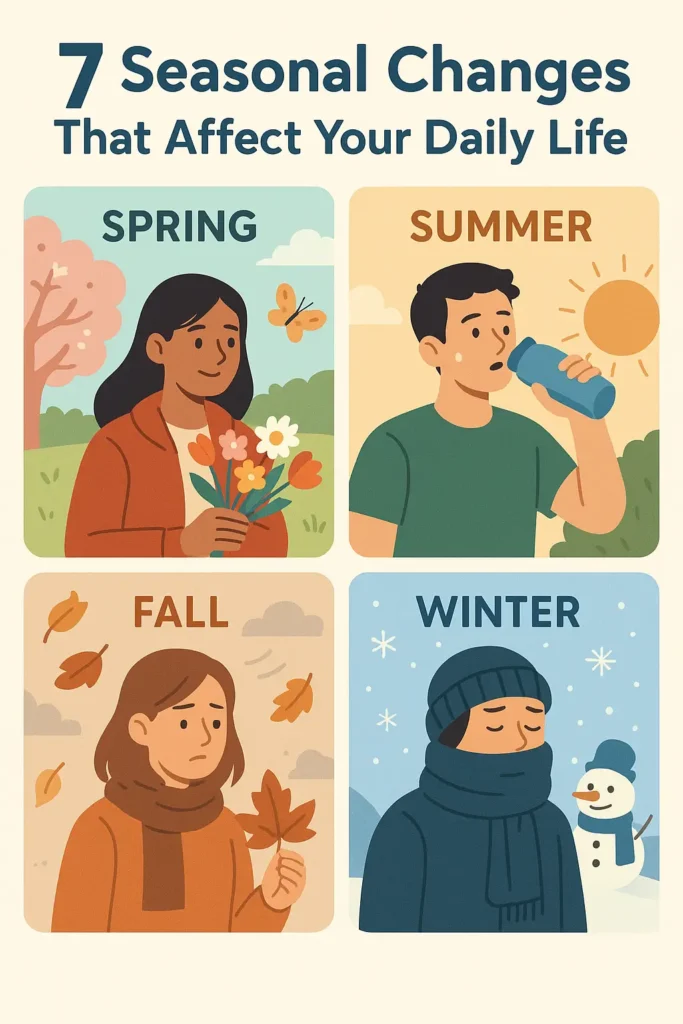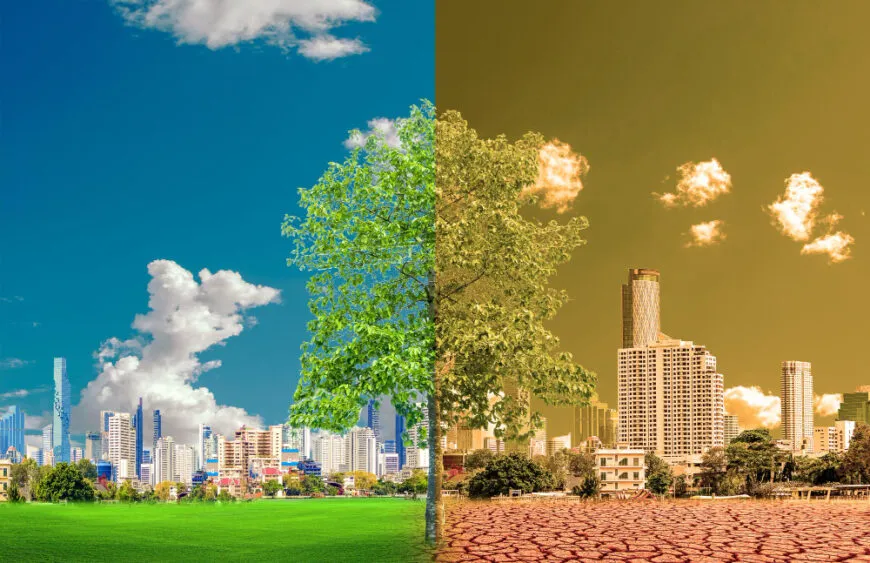Introduction;
As the Earth tilts on its axis and revolves around the sun, we experience the inevitable rhythm of the seasons. From the blooming of spring flowers to the crisp air of autumn, these shifts are more than just a change in weather. They have a profound and often surprising impact on our bodies, minds, and daily routines. The way we dress, what we eat, and even our mood are all subject to the powerful influence of the seasons. Understanding the most significant seasonal changes that affect your daily life is key to not only adapting but thriving throughout the year. These shifts, from the length of daylight to temperature fluctuations, shape our habits and well-being in ways we often don’t even realize.

- How to Stay Motivated Every Day: A Step-by-Step Guide
- What Psychology Tricks Can Simplify Your Daily Life?
- How to Build Self Discipline in 30 Days
- 7 Morning Habits That Will Change Your Life
- Quick Guide: Stop Overthinking Fast and Effectively
1. The Impact of Daylight and Darkness on Sleep and Mood
One of the most immediate and noticeable seasonal changes that affect your daily life is the fluctuation in the amount of daylight. In the summer, long days and late sunsets can make it difficult for our bodies to wind down. The presence of light, especially blue light from the sun, suppresses the production of melatonin, the hormone that regulates sleep. This can lead to lighter sleep or difficulty falling asleep, resulting in a feeling of being tired despite having had a full night’s rest.
Conversely, the shorter, darker days of winter can have the opposite effect. The lack of sunlight can disrupt our circadian rhythm, making us feel more lethargic and sleepy during the day. For some, this lack of light can even trigger Seasonal Affective Disorder (SAD), a type of depression linked to seasonal changes. The reduced exposure to sunlight, which is a natural source of Vitamin D, can also lead to deficiencies that impact mood and energy levels. This powerful shift in daylight is a primary driver of how we feel and function.
2. Changes in Temperature and Their Effect on Physical Health
The shift in temperature from one season to another has a direct and significant impact on our physical health. Hot summer days can lead to dehydration, heatstroke, and an increased strain on the cardiovascular system. Our bodies work hard to maintain a stable internal temperature, and during extreme heat, this can be a taxing process. Many people find they have less energy for physical activity in the summer due to the heat, which can lead to a more sedentary lifestyle.
Winter, on the other hand, brings its own set of challenges. Cold weather can constrict blood vessels, increasing blood pressure and putting stress on the heart. It also makes us more susceptible to illnesses like the common cold and flu, as we spend more time indoors in close proximity to others. Furthermore, the dry air of winter can irritate the skin and respiratory system. The drastic temperature seasonal changes that affect your daily life require us to adjust our routines, from how much water we drink to how we dress to protect ourselves.
3. The Influence of Seasonal Allergies on Your Well-being
For millions of people, the arrival of spring and early summer brings not just blooming flowers, but also the misery of seasonal allergies. Pollen from trees, grasses, and weeds can cause a range of symptoms, including sneezing, itchy eyes, and a runny nose. These allergies can be debilitating, affecting everything from your ability to concentrate at work to your desire to enjoy outdoor activities. The air is literally filled with triggers for these reactions.
Autumn also has its own set of allergens, with ragweed being a major culprit. For many, this makes the transition into fall a challenging time for their health. Managing these allergies often requires a proactive approach, including medication, and a keen awareness of pollen counts. The cycle of seasonal changes that affect your daily life and health is a constant battle for allergy sufferers, shaping their day-to-day choices about where they go and what they do.
4. The Impact on Diet and Nutrition
Our diet and eating habits are surprisingly linked to the seasons. In the summer, we often crave lighter, more hydrating foods like fresh fruits and salads. The abundance of fresh, local produce also makes it easier to eat a diet rich in vitamins and nutrients. This natural inclination towards seasonal eating is a result of both what’s available and what our bodies instinctively need.
Come winter, however, our cravings often shift. We tend to desire heavier, more comforting foods like stews and roasted vegetables. This is partly due to the body’s need for more energy to stay warm. The shorter days can also lead to a decrease in Vitamin D intake, as sunlight is our main source. This is a profound example of how seasonal changes that affect your daily life influence our most basic biological needs. Eating seasonally not only supports local agriculture but also aligns with what our bodies naturally need at different times of the year.
5. Changes in Exercise and Outdoor Activities
The seasons have a massive influence on our physical activity levels and the types of exercises we prefer. In the spring and summer, the pleasant weather and long days make outdoor activities like hiking, cycling, and running more appealing. The ability to spend more time outside can boost our mental health and provide an opportunity for social interaction. It’s a time of year when it feels natural to be more active.
However, the colder, darker months of winter often lead to a decrease in outdoor exercise. Many people shift their workouts indoors, to gyms or home workouts. The reduced daylight can make it harder to find time for physical activity after work. This change in routine can sometimes lead to a feeling of being less active and can be a contributing factor to the “winter blues.” Recognizing these seasonal changes that affect your daily life allows you to plan your exercise routine in a way that keeps you active and healthy year-round.
6. The Effect on Skin and Hair Health
The skin and hair are often the first to show the signs of seasonal change. In the summer, increased sun exposure can lead to sunburn, accelerated aging, and a higher risk of skin cancer. The humidity can also make hair more prone to frizz. Protecting our skin with sunscreen and our hair with specific products becomes a necessity.
Winter, on the other hand, brings dry, cold air that can strip the skin of its natural moisture, leading to dryness, flakiness, and irritation. Low humidity can also make hair brittle and prone to static. Many people find they have to adjust their skincare and haircare routines completely in the winter, adding more moisturizing products to combat the dryness. This is a stark reminder of how seasonal changes that affect your daily life are literally visible on the surface of our bodies.

7. The Social and Cultural Rhythm of the Seasons
Beyond the physical and health-related changes, seasons also dictate much of our social and cultural lives. Summer is a time for vacations, BBQs, and outdoor gatherings. The long days and pleasant weather create a natural inclination to socialize and explore. The social calendar is full of events that are inherently tied to the season.
As we move into autumn and winter, the focus shifts. Fall brings holidays like Halloween and Thanksgiving, while winter is synonymous with festive seasons and cozy indoor gatherings. The colder weather encourages us to spend more time at home, with family and friends. This change in social rhythm is a crucial part of the seasonal changes that affect your daily life. From our holidays to our hobbies, the seasons shape the very fabric of our social interactions, guiding us through a yearly cycle of celebration and rest. The sheer power of these changes to alter our collective behavior is truly astonishing.








